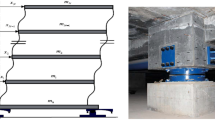Abstract
The Triple Friction Pendulum (TFP) bearing consists of two facing concave steel surfaces separated by an internal nested assembly of two facing concave surfaces separated by an articulated slider. In spite of being fully passive device, TFP bearing exhibits adaptive behavior under different hazard level of earthquakes owing to multiple sliding surfaces. The paper describes response of TFP bearing under near-fault earthquake ground motions with directivity focusing and fling step and compared with far-field ground motions. A set of 18 records comprising of six far-field and twelve near-fault ground motion, six with directivity effect and six with fling step, are used for the study. Behavior of TFP bearing is studied by changing the radius of curvature and coefficient of friction of outer surfaces contributing significantly under near-fault event. Further, a parametric study of TFP isolated building is also carried out using simple sinusoidal pulse motions to achieve clear insight of the effects of forward directivity and fling step. It is observed that near-fault ground motion with forward directivity pulses result in higher demands than the fling step pulses due to the backward and forward momentum gained during the initial and final phase of the directivity pulse. Moreover, TFP bearing is found effective in reducing base shear, absolute acceleration and isolator displacement compared to friction base-isolation system with single sliding surface.
Similar content being viewed by others
References
Ahmadi, G. (2013). “Stochastic earthquake response of structure on sliding foundation.” International Journal of Engineering and Science, Vols. 21, No. 2, pp. 93–102, DOI: 10.1016/0020–7225(83) 90001–0.
Alavi, B. and Krawinkler, H. (2004). “Behaviour of moment resisting frame structures subjected to near-fault ground motions.” Earthquake Engineering Structure Dynamics, Vol. 33, pp. 687–706.
Becker, T. C. and Mahin, S. A. (2011). Advanced modelling of the performance of structures supported on triple friction pendulum bearings, PhD Thesis, University of California, Berkeley.
Buckle, I. G. and Mayes, R. L. (1990). “Seismic isolation: History, application and performance-A world view.” Earthquake Spectra 1990, Vol. 6, No. 2, pp. 161–201, DOI: 10.1193/1.1585564.
Constantinou, M. C., Mokha, A. S., and Reinhorn, A. M. (1990), “Teflon bearings in base isolation II: Modeling.” Journal of Structural Engineering (ASCE) 1990, Vol. 116, No. 2, pp. 455–474, DOI: 10.1061/(asce)0733–9445(1990)116:2(455).
Fadi, F. and Constantinou, M. C. (2010). “Evaluation of simplified methods of analysis for structures with triple friction pendulum isolators.” Earthquake Engineering Structural Dynamics, Vol. 24, No. 1, pp. 5–22. DOI: 10.1002/eqe.930.
Fenz, D. M. and Constantinou, M. C. (2008b). “Modelling triple friction pendulum bearings for response history analysis.” Earthquake Spectra, Vol. 24, No. 4, pp. 1011–1028, DOI: 10.1193/1.2982531.
Fenz, D. M. and Constantinou, M. C. (2006). “Behaviour of the double concave friction pendulum bearing.” Earthquake Engineering and Structural Dynamics, Vol. 35, No. 11, pp. 1403–1424, DOI: 10.1002/eqe.589.
Fenz, D. M. and Constantinou, M. C. (2008). “Spherical sliding isolation bearings with adaptive behavior: Theory.” Earthquake Engineering and Structural Dynamics, Vol. 37, No. 2, pp. 163–183, DOI: 10.1002/eqe.751.
Fenz, D. M. and Constantinou, M. C. (2008a). “Spherical sliding isolation bearings with adaptive behavior: Experimental verfication.” Earthquake Engineering and Structural Dynamics, Vol. 37, No.2, pp. 185–205, DOI: 10.1002/eqe.750.
Heaton, T. H., Hall, J. F., Wald, D. J., and Halling, M. W. (1995). “Response of high-rise and base-isolated buildings to a hypothetical Mw 7.0 blind thrust earthquake.” Science, Vol. 267, No. 5195, pp. 206–211, DOI: 10.1126/science.267.5195.206.
Kalkan, E. and Kunnath, S. K. (2006). “Effects of fling step and forward directivity on seismic response of buildings.” Earthquake Spectra, Vol. 22, No. 2, pp. 367–390, DOI: 10.1193/1.2192560.
Kalkan, E., Adalier, K., and Pamuk, A. (2004). “Near field effects and engineering implications of recent earthquakes in Turkey.” Proceedings, 5th International Conference on Case Histories in Geotechnical Engineering, New York, NY, pp. 3–30.
Kim, Y. S. and Yun, C. B. (2005). “Analysis and design of double friction pendulum systems for seismic isolation,” The Second International Conference on Structural Health Monitoring of Intelligent Infrastructure, Korea.
Malekzadeh, M. and Taghikhany, T. (2012). “Multi-Stage performance of seismically isolated bridge using triple pendulum bearing.” Advances in Structural Engineering, Vol. 15, No. 7, pp. 1181–1196, DOI: 10.1260/1369–4332.15.7.1181.
Naeim, F. and Kelly, J. M. (1999). Design of seismic isolated structures: From theory to practice, Wiley, New York.
Sarlis, A. S. and Constantinou, M. C. (2011). Modelling triple friction pendulum isolator in program SAP2000, MCEER Report, University of New York, Buffalo.
Sasani, M. and Bertero, V. V. (2000). “Importance of severe pulse-type ground motions in performance-based engineering: Historical and critical review.” Proceedings, 12th World Conference on Earthquake Engineering, Paper No. 1302.
Somerville, P. G. (1998). “Development of an improved representation of near-fault ground.” SMIP98 Proceedings, Seminar on Utilization of Strong-Motion Data, Oakland, CA, Sept. 15, California Division of Mines and Geology, Sacramento, CA, pp. 1–20.
Soni, D. P., Mistry, B. B., Jangid, R. S., and Panchal, V. R. (2011). “Seismic response of the double variable frequency pendulum isolator.” Structural Control Health Monitoring, Vol. 18, No. 4, pp. 450–470, DOI: 10.1002/stc.384.
Tsai, C. S., Chen, W. S., Chiang, T. C., and Chen, B. J. (2006). “Component and shaking table tests for full-scale multiple friction pendulum system.” Earthquake Engineering and Structural Dynamics, Vol. 35, No. 10, pp. 1653–1675, DOI: 10.1002/eqe.598.
Warn, G. P. and Ryan, K. L. (2012). “A review of seismic isolation for buildings: Historical development and research needs.” Buildings, Vol. 2, No. 4, pp. 300–325, DOI: 10.3390/buildings2030300.
Wen, Y. K. (1976). “Method for random vibration of hysteretic systems.” Journal of Engineering Mechanics (ASCE), Vol. 102, pp. 249–263.
Author information
Authors and Affiliations
Corresponding author
Rights and permissions
About this article
Cite this article
Dhankot, M.A., Soni, D.P. Behaviour of Triple Friction Pendulum isolator under forward directivity and fling step effect. KSCE J Civ Eng 21, 872–881 (2017). https://doi.org/10.1007/s12205-016-0690-3
Received:
Accepted:
Published:
Issue Date:
DOI: https://doi.org/10.1007/s12205-016-0690-3




